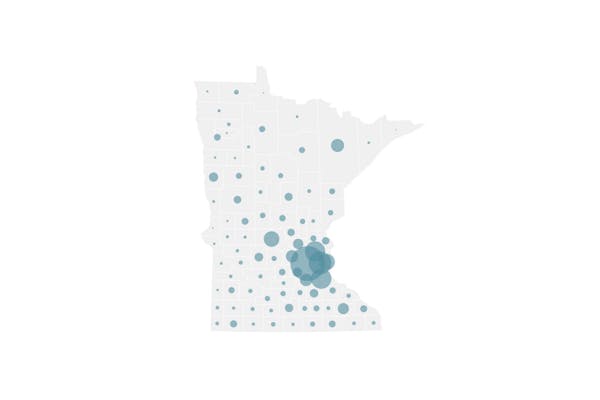Minnesota has changed its guidance from avoiding COVID-19 vaccine waste at all costs to risking a little waste if it allows providers to get more shots in arms.
The Minnesota Department of Health's official provider guide was updated Friday with a section previously titled "do not waste vaccine" renamed "do not miss an opportunity to vaccinate."
State infectious disease director Kris Ehresmann said the original policy was devised this winter when vaccine doses were extremely limited and "treated like gold," but supplies have increased and the new challenge is making sure shots are available when people want them.
"If someone walks up [to a vaccine clinic] and says they want to be vaccinated, and it's the end of the day, we want to get that person vaccinated," she said. "We don't want to miss that chance."
Minnesota remains a national leader in vaccine efficiency and in its per capita rate of doses administered, but progress has slowed. The state on Wednesday reported that more than 2.7 million people have received at least a first shot, and nearly 2.4 million of them have completed the one- or two-dose series. But the number of shots has declined from 407,673 in the week starting April 4 to 223,115 in the week starting May 9.
Minnesota still has a goal of providing first doses to 70% of people 16 and older by July 1, state Health Commissioner Jan Malcolm said, even though eligibility for the Pfizer vaccine was extended last week to people 12 to 15 years old.
The original idea behind that goal was to incentivize vaccination by promising to lift the state's public indoor mask mandate when it reached 70%. But that incentive ended when Gov. Tim Walz lifted the mandate last week in response to new guidance from the U.S. Centers for Disease Control and Prevention.
"It's still a good marker for us," Malcolm said.
A 70% vaccination rate in people 16 and older would mean the administration of 3,087,404 first doses, leaving Minnesota about 350,000 shots short right now.
A separate goal could be set just for the 283,000 Minnesotans 12 to 15 who are newly eligible for vaccine. The latest state data indicate that more than 20,000 of them have received shots in the past week.
Three teenage children of state executives received shots at the Mall of America on Wednesday as part of a press event by Walz to promote COVID-19 vaccination in the new age group. The state's mall vaccine site will prioritize shots for this age group through Saturday.
"The sooner those [vaccination numbers] go up, the better we protect our neighbors, the better we protect against any potential surge coming back," Walz said.
Vaccine waste has been uncommon in Minnesota, despite the ultracold storage requirements of the Pfizer and Moderna COVID-19 vaccines and their limited shelf lives.
More than 5.7 million vaccine doses have been distributed to Minnesota, and only 3,522 have been reported as wasted. That includes 927 doses that weren't used after vials were opened and 552 doses that were drawn into syringes but never injected.
Ehresmann said the new approach isn't a "free-for-all" that will result in substantially more waste. Minnesota still must report wastage to federal regulators who control supply levels and many places in the world are desperate for more doses.
"We certainly don't want to be cavalier," she said. "It's a balance."
On the other hand, increasing on-hand supplies at clinics and walk-in events could increase vaccinations. The state has converted metro buses into mobile vaccine clinics and is using other strategies to get shots to people who otherwise don't have access because of limited time or transportation options.
"We do have an obligation to make sure we're getting Minnesotans vaccinated," she said.
State health officials believe Minnesota's vaccination progress has made a difference in shortening the severity and length of the latest COVID-19 wave.
The state reported 15 COVID-19 deaths on Wednesday along with 658 infections with the novel coronavirus that causes the respiratory disease. That was the lowest single-day total reported on a Wednesday in 2021.
The state also reported a COVID-19 test positivity rate of 4.9% for the seven-day period ending May 10 — dropping below the 5% caution threshold for the first time since mid-March.
COVID-19 hospitalizations have declined in Minnesota from a recent peak of 699 on April 14 to 420 on Tuesday.
Minnesota earlier in the pandemic had set a goal of vaccinating 80% of eligible people in order to achieve a level of "herd immunity" that would curtail viral transmission.
Ehresmann said even a rate that high might not prevent COVID-19 entirely but could reduce it to more of an occasional or manageable level.
"I personally was never defining herd immunity as eradication of COVID-19," she said. "When you think about herd immunity of measles, we currently have elimination of measles in the U.S., but we don't have eradication. The whole concept of herd immunity is you've vaccinated enough people to make it that much harder for the virus to find the susceptible people."
SARS-CoV-2 infection after vaccination remains possible — with Minnesota now reporting 2,249 breakthrough infections that include 206 hospitalizations and 24 deaths. However, those breakthrough infections represent only 0.1% of the more than 2 million people in Minnesota who have been fully vaccinated — which means it has been 14 days since they received their last dose.
Staff writer Glenn Howatt contributed to this report.
Jeremy Olson • 612-673-7744
Carolyn Parnell, 'trailblazer' who served as Minnesota's first IT commissioner, dies

